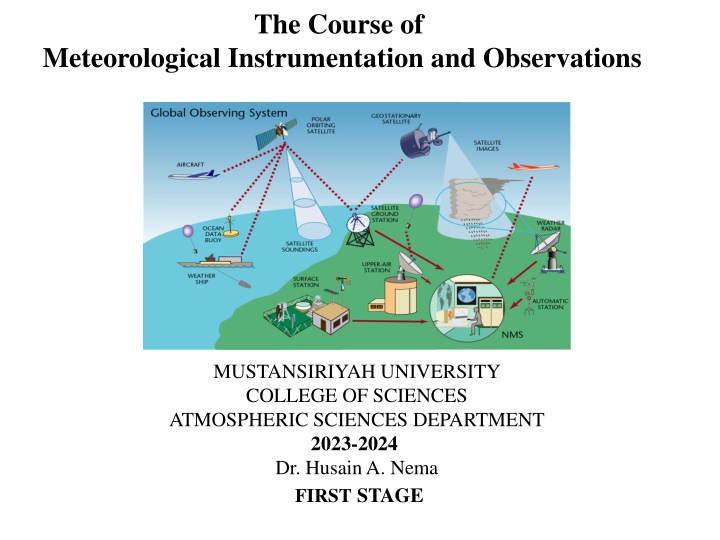
Meteorological Instrumentation and Observations at Mustansiriya University
Welcome, students! Dive into the world of meteorological instrumentation and observations at Mustansiriya University's College of Sciences. Dr. Husain A. Nema guides you through the first stage of the course, focusing on precipitation. Learn about the basics of precipitation, its measurement, forms, and estimation techniques like Quantitative Precipitation Estimation (QPE) using rain gauges. Gain insights into how precipitation is vital in understanding weather patterns and forecasting.
Uploaded on | 0 Views
Download Presentation

Please find below an Image/Link to download the presentation.
The content on the website is provided AS IS for your information and personal use only. It may not be sold, licensed, or shared on other websites without obtaining consent from the author. If you encounter any issues during the download, it is possible that the publisher has removed the file from their server.
You are allowed to download the files provided on this website for personal or commercial use, subject to the condition that they are used lawfully. All files are the property of their respective owners.
The content on the website is provided AS IS for your information and personal use only. It may not be sold, licensed, or shared on other websites without obtaining consent from the author.
E N D
Presentation Transcript
The Course of Meteorological Instrumentation and Observations MUSTANSIRIYAH UNIVERSITY COLLEGE OF SCIENCES ATMOSPHERIC SCIENCES DEPARTMENT 2023-2024 Dr. Husain A. Nema FIRSTSTAGE
Welcome Students! TO LECTURE FOUR PRECIPITATION
Precipitation Precipitation refers to any product of the condensation of atmospheric water vapor that is deposited on the Earth's surface. Precipitation intensity can be measured by precipitation rate (R), which is normally defined as the rain water falling on ground per unit area per unit time, of unit in SI system which is the same concept of mass flux. So, basically precipitation rate is measured by depth per unit time. m/s is too large for precipitation measurement. In real practice, we usually use unit of mm/h. s m mm 6 . 3 = 6 1 10 h
Precipitation Estimation (QPE) The term Quantitative Precipitation Estimation, or QPE, refers to the estimation of observed precipitation. Observed precipitation is only an estimate because the tools used provide inexact approximations of the actual magnitude and distribution of precipitation. RAIN GAUGE Precipitation can be measured at a fixed location (point estimates) by a rain gauge, and will not necessarily provide good spatial resolution. It measures rain as well as the liquid equivalent of frozen precipitation that has fallen over a specific time period. Rain gauges come in a variety of styles, both manual and automated.






















